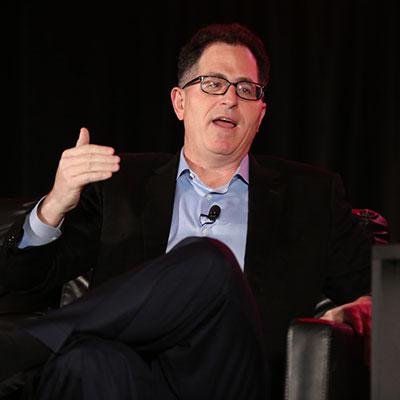CRN Exclusive: Michael Dell On Integrating 'Extremely Closely' With VMware And Public Cloud 'Rationalization'

Michael Dell: 'Better Together'
Dell Technologies CEO Michael Dell says the "better together" strategy at the heart of the Dell Technologies story is hitting its stride with Dell EMC now holding the number one market share position in both servers and storage and with VMware VxRail and VxRack hyperconverged offerings growing at a triple digit clip.
"Our 'better together' strategy is working extremely well and you see the results," said Dell, in an interview with CRN. "The power of these seven technology leaders coming together [resulted] in a very strong first quarter across the board in terms of revenue, growth, profitability, free cash flow and obviously we have an industry leading channel program. It's driving coverage. We're seeing strong cross selling across the family."
In an interview with CRN, Dell talks about VMware technology integration, public cloud costs, channel momentum and his networking vision.

How will you leverage VMware to win more market share?
VMware is number one in private and hybrid cloud, and obviously VMware is part of the Dell Technologies family. We're going to continue to leverage that. We have a long history here of integrating the technologies closer together. This is what customers have been asking us for do. It is what we're doing. It is working really well. There's much, much more to come here. And of course, virtualization and software-defining the data center is extending beyond servers and storage into the network and moving toward this idea of autonomous operations. Together, Dell EMC, VMware and Pivotal have leading technologies to win here. It's demonstrated not only by the scale of the investment that we're making – we've invested over $12 billion in [Dell Technologies] R&D in the last three years – it's also demonstrated by our industry leadership in terms of revenue, growth and share.

What's your vision for Dell-VMware integration and why is Dell's infrastructure portfolio the best place to run VMware?
VMware still has an open ecosystem. We're not talking about VMware at the exclusion of others, but certainly Dell EMC -- as the leading infrastructure company in the world and both companies are part of the same family of companies -- we're integrating extremely closely. Again, this is what customers want. Our teams are deeply connected on a technical level. You are seeing more and more joint product development with Dell EMC being the best way to express VMware software in hardware and increasingly delivering appliances and solutions that are completely integrated.

Talk about VMware momentum working more closely now with Dell?
VMware did really well, 22 percent growth year over year in license revenue. It was the fastest growth in license revenue since the first quarter of 2011. If you look back at the last six quarters since the close of the Dell EMC VMware combination, you'll notice that the license growth has been increasing quite consistently and rapidly for VMware. Certainly, our 'better together' strategy is working extremely well and you see the results. Operating margins at VMware were 29.8 percent, and we continue to believe that networking will eventually be as big or bigger than compute, given the extension of NSX into telco and WAN – particularly the software-defined WAN.

Are you seeing more cross selling across the entire Dell Technologies' seven brands?
If we had a theme for the first quarter, it would be 'better together'. The power of these seven technology leaders coming together [resulted] in a very strong first quarter across the board in terms of revenue, growth, profitability, free cash flow and obviously we have an industry leading channel program. It's driving coverage. We're seeing strong cross selling across the family. If you look at the Q1 performance, it was strong and balanced across all business units, all regions, all customer segments. Revenues were up 19 percent YOY, we had double digit growth in servers, networking, in storage and commercial client and VMware.

What are customers saying when you talk about public cloud cost versus software-defined, on-premise data center solutions?
First of all, I'd point you to our 41 percent revenue growth we had in the first quarter with servers – that's an informative data point. It's not really the private cloud versus the public clouds, it's both. What we're seeing is that it's a workload independent discussion. Certainly, when you automate and modernize the on-premise systems, they become extremely efficient – that's why we're number one in hyper-converged and it's growing triple digits. Yes, there's been a rationalization of the enthusiasm for the public cloud. As many customers began to implement that, they found that it was great for some things and not great for other things. At the same time, the on-premise systems were getting better and better.

Why do you think this shift is occurring?
If you step back and say, 'Well, what can the public cloud do?' Well it software-defines everything and automated everything. That's a great idea, but it's not owned by the public cloud. So all the work that we're doing collectively across Dell Technologies in creating this autonomous operations of infrastructure, it gives customer the flexibility to decide where they put their workloads across the continuum of public, private, hybrid, managed services and software as a service. And the answer there is not everything goes one place or another place. It's both.

Storage sales and market share at Dell EMC has exploded. How much bigger to you expect to grow market share with the new simplified storage product strategy?
There's a lot to grow. If you look at the storage business and the server business and you try to say that these things are distinctly different, that becomes harder and harder over time. In other words, you have software-defined storage, you have hyper-converged, you got scale out – the reality is we're number one in both and we're growing in both. Increasingly, it looks like one business which is really good. That was our objective. Yes, we're continuing to simplify the offerings and all that is resonating extremely well with partners and customers. That's why we're growing and winning.

What's your networking vision for Dell VMware?
We're certainly seeing strong growth in software-defined networking and open networking. Those are areas where we have a leadership position. The VeloCloud acquisition by VMware is off to a great start. I believe we have about 2,000 customers now and a leading position in that. But if you step back and look more broadly at what's going on here, the turning of hardware into software in the form of virtualization was a big deal for compute and servers in the early 2000s and was a foundational element of all of what we know today in the infrastructure. We're seeing that same phenomenon now occur in the network. What you can do with management, automation and security by software-defining the network, is absolutely game-changing. Customers are hearing about it. We're quite well positioned to win there.

Are businesses still willing to spend tens-of-thousands of dollars on a network switch from your competitors?
In the infrastructure, this goes back to four years ago when we had the idea to create Dell Technologies, it's not so much about the silos anymore. In other words, 'Yes you need networking. Yes you need storage and servers, but ultimately you need all of those together with software.' This is why the combination makes so much sense and you're seeing that in our results. The competitors that are focused on one particular silo, I think that game going to get harder and harder. We're unique in our capabilities here from the entire aspect.

How critical is Dell's $4 billion annual R&D budget with 80% of engineers focused on software-defined?
There's a ton of innovation that goes into these products and solutions – it's increasingly software. When you include VMware, Pivotal and the whole family, I think it's actually closer to 90 percent of the engineers focused on software at Dell Technologies. There's no question that there's a ton of innovation. The new requirements that we're constantly learning from customers on needs that are out there require a substantial investment. We're investing aggressively against those requirements. Customers are responding very positively to that.

How is the channel momentum at Dell?
The channel momentum continues to be very strong. The channel business at Dell Technologies is a $43 billion business. First quarter revenues were up again double digits. We had more cross selling with the better together theme. The average number of LOBs (Dell lines of business) being sold by partners was up roughly 10 percent and we grew double-digits in the first quarter [2018] just like we did in the fourth quarter [2017] and like we did all last year. We had more deal registrations in the first quarter [2018] than we did in the fourth quarter [2017] by a meaningful amount. Dell Financial Services (DFS) did extremely well. Our DFS originations in the channel grew 68 percent year over year. In the United States it grew about 100 percent. We know that partners who finance with DFS has historically grown about twice as fast as those who don't. That's where we're driving strong with our partners.